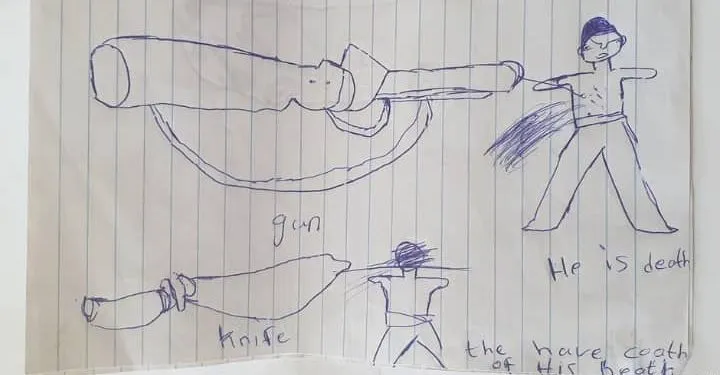With the crisis in the Anglophone regions now in its 5th year, the most neglected impact perhaps has been the one on the children.
Speaking exclusively to German media, DW, ReachoutCameroon, a Non-Governmental Organisation located in the Southwest region in Cameroon, one of the zones in conflict spoke extensively on the damaging effects this conflict has had on the children.
A caseworker at Reachout Cameroon, Tatiana Bie from Kumba explained to DW that she had given some kids in an orphanage a simple task to draw anything that appealed to them in 15 minutes.
“After 15 minutes, the kids had completed their task. Most of them were drawing weapons, guns and armored cars,” she said.
Ever since the Anglophone Crisis broke out in 2016, pupils, students, and teachers have been prime targets from both the Government forces and Separatists fighters.
The shocking depictions in the children’s drawing as sampled by ReachOut Cameroon are valid proof that the children have become accustomed to violence and bloodshed in their daily lives.
The series of drawings presented by the children are valid proof that violence is nothing close to sporadic around them.
“The kids can even tell differences between weapons,” reveals Serna, one of the staff at ReachOut Cameroon to DW. He also pointed out that these children were never given specific directives on what to portray in their drawings.
They were simple but very striking in the way they were depicted with jaw-dropping details. Dr. Shelly Evans, a counselor who has worked with children affected by conflict in Uganda, Sudan, and Sierra Leone, has seen the drawings. The pictures, she says, “suggest that this is what they are living every day.”
“The pictures were drawn in just black or blue ink. But the blood was prominent in bright red ink, so everything else was just kind of faded into the background, except the blood,” said another staff, Evans.
“Also, the size of the weapons was enlarged in some of the drawings. That takes up most of their thought,” he added.
The depiction of some of these characters armed with weapons and smiling faces is another indication of a psychological acceptance from these kids that violence and bloodshed have become a norm to them according to Evans.
Opining on the long terms effects that these have had on the children, Serna told DW that children in rural areas most especially would be left with gaps academic-wise which will prevent them from integrating with the rest of their peers who are far ahead.



